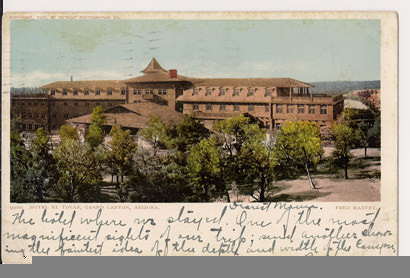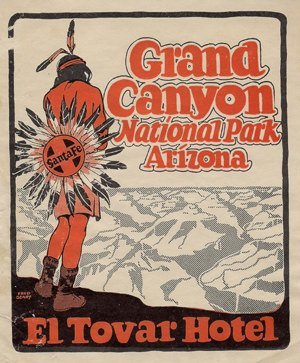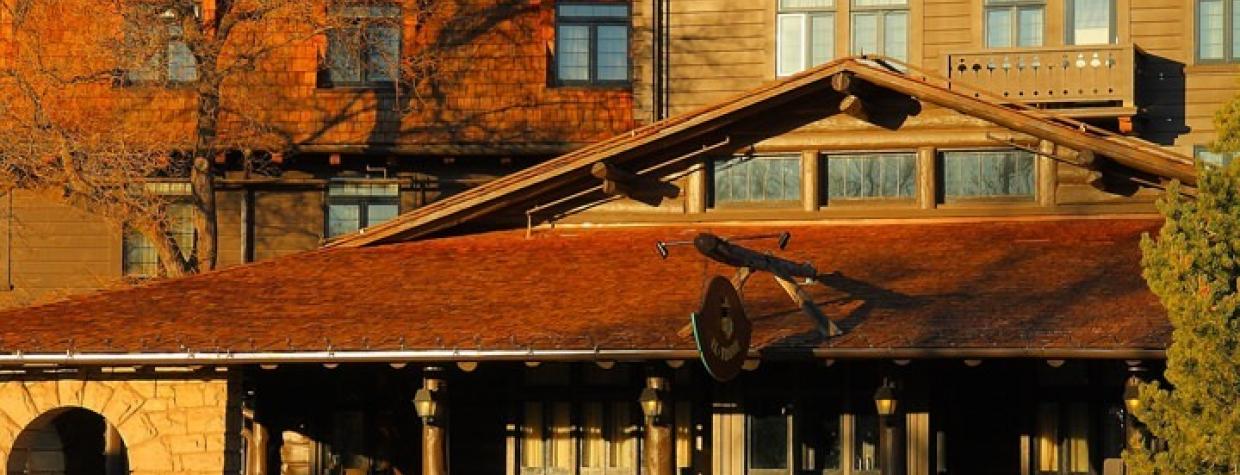A new Grand Canyon book has hit the scene, but this one has a twist. Suzanne Silverthorn, the co-author of Grand Canyon: Past and Present, is an avid collector of vintage postcards featuring scenes from the national parks of the West. According to Silverthorn, her interest in postcards and national parks is drawn from her experiences summering in her family cabin in Grand Lake, Colorado, as a child, and a train trip she took with her grandmother to the Grand Canyon when she was 10 years old. Years later, she discovered an old box of brochures, maps, and postcards she had sent to her family in that time. So began the process of sorting through other family possessions and collecting other souvenirs from her trips to the West's national parks."
As I began acquiring these postcards," Silverthorn says, "I was immediately struck by the grit and determination of the early-day sightseers and what was required to reach the parks — first by dusty stagecoach and horseback trails, then the more comfortable, but exclusive train excursions, and later by auto — the great equalizer. I became fascinated with the evolution of national-park tourism and the men and women who devoted their lives and fortunes to create the camps, lodges, roads and other visitor services to accommodate this new industry.”
The result is a compilation of photographs and keepsakes of the Grand Canyon that serves as a timeless account of the park’s significance, not only for its beauty and grandeur, but also for its focus on society’s contributions to the park in its transformation as a tourism destination over time. “The combination of past and present images shows an evolving landscape within a man-made environment and its juxtaposition with the incredible scenery,” Silverthorn says. We asked the author a few questions about the process of compiling this unique collection of Grand Canyon memorabilia.

A postcard of El Tovar, circa 1906. The sender describes the breathtaking view of the Grand Canyon from the hotel. | Courtesy of Suzanne Silverthorn
Q: Describe the format and contents of the book.
A: The book uses a combination of postcard images and present day photography to offer a timeless account of the park’s scenic and historical significance. With chapters on the South Rim and North Rim, the book introduces readers to the park’s early promoters, including prospectors and homesteaders. Also featured are the significant contributions of the Santa Fe and Union Pacific railroads. It’s a pictorial account in which historic postcards are paired with award-winning images of today, courtesy of landscape photographer I-Ting Chiang. Scenes include dramatic rim views and rugged trail-side settings, plus El Tovar and other historic properties once operated by the Fred Harvey Co., as well as the stone-sculpted visitor facilities crafted by Mary Colter. Together, these images tell the story of the development of modern tourism in the Grand Canyon. The book is a treasured keepsake for history buffs and an inspiration to others who marvel at the adventurous spirit of the early entrepreneurs.
Q: What inspired you to write this book?
A: What I find remarkable about the Grand Canyon is the timeless appeal it has on our souls. It’s an emotional and spiritual connection that transcends our ancestry and culture. And while those who came before us weren’t particularly well traveled, their instincts told them this was a special place — a place to be shared with others. The inspiration for the book comes from an admiration of the early-day pioneers that devoted their livelihoods to share the park with those who had longed to see such a site while paving the way for today’s visitors. The past and present images demonstrate the park’s scenic timelessness while also illustrating the progression as a tourism destination. While many readers will connect with the book to reminisce about earlier visits, my hope is that new visitors will not only be moved by their own experiences associated with the park’s majestic views, but will use the book to appreciate the park’s fascinating cultural history and preservation efforts.

A vintage El Tovar decal, produced by the Santa Fe Railway and the Fred Harvey Co. | Courtesy of Suzanne Silverthorn
Q: What did you enjoy most about the process of compiling this book?
A: I enjoyed the research associated with the book, which led me to connect with some wonderful people who graciously offered their help and support. The list includes author Michael F. Anderson, an expert on the park’s history; Wayne Ranney of the Grand Canyon Historical Society; Michael Quinn with the National Park Service; Julie Herrick with BNSF Railway; and Patricia LaBounty with the Union Pacific Railroad Museum. I thoroughly enjoyed poring over old brochures and pamphlets published by the railroads and the National Park Service. The material in these early publications included lodging rates, what to wear, what to do, how to get there, etc. The postcards, too, offered an interesting glimpse into the past with first-hand accounts of early travels to the Grand Canyon. I also found the reference librarians at my local library to be extremely helpful in assisting in the research of elusive dates and other details. It was a great reminder of the tremendous resources and personal assistance offered by our local libraries.
Q: What were some of the challenges or surprises you encountered in compiling this book?
A: Before I began researching the book, I had no idea of the contributions of Mary Colter and her design influences throughout the Southwest. She was clearly ahead of her time in the way she approached the design and construction of Hopi House, Phantom Ranch and her other projects within the park and is only now receiving the kind of recognition she deserves as a pioneering architect. Look for additional discussions on the Fred Harvey/Mary Colter fan page on Facebook.
Q: Do you have any more projects lined up?
A: This month, a yearlong celebration of the 100th anniversary of Rocky Mountain National Park will be taking place. I’ll be working with the libraries in Grand Lake and Estes Park, Colorado, to help commemorate the anniversary later in the year. I’ll also continue to add to my postcard collection. My goal is to acquire postcards of every lodge from every decade from every national park.
Q: Where can the public find out more about you and your new book?
A: The Grand Canyon book is the fourth in a series of past and present books; the other books are profiles on Glacier, Yellowstone and Yosemite national parks. Ask your local library to obtain copies of any of these books from the interlibrary-loan program. Copies are available for sale at www.schifferbooks.com or www.amazon.com.
— Alexandra Winter

